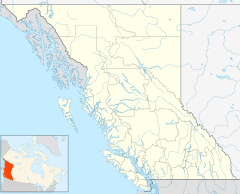Height of the Rockies Provincial Park facts for kids
Quick facts for kids Height of the Rockies Provincial Park |
|
|---|---|
|
IUCN Category Ib (Wilderness Area)
|
|
| Location | East Kootenay, British Columbia, Canada |
| Area | 54,170 ha (209.2 sq mi) |
| Established | July 12, 1995 |
| Governing body | BC Parks |
Height of the Rockies Provincial Park is a special natural area in the Canadian Rockies. It is located in southeastern British Columbia, Canada. This park is found west of the Continental Divide, which is like a big mountain ridge. In this area, the Continental Divide also forms the border between British Columbia and Alberta. The park is right next to Elk Lakes Provincial Park.
Contents
Discover Height of the Rockies Park
This park covers a huge area of 54,170 hectares (about 133,857 acres). It sits on the western side of the Continental Divide. This divide acts as the border between British Columbia and Alberta.
Park Neighbors and Access Points
Height of the Rockies Provincial Park shares a border with Elk Lakes Provincial Park in British Columbia. A trail connects these two parks. It also borders Banff National Park and Peter Lougheed Provincial Park in Alberta.
The park is east of Invermere. The closest towns are Elkford to the south and Canal Flats and Radium Hot Springs to the west. You can get into the park by walking or riding a horse. There are logging roads and trails leading to six different starting points.
Park Rules and Features
No cars, motorcycles, or other machines are allowed inside the park. This helps keep the wild nature safe. There are no campgrounds or other services like shops or restrooms. This means visitors need to be prepared for a true wilderness experience. The famous Great Divide Trail also goes through this park.
Mountains, Rivers, and Lakes
The park is mostly an alpine area, meaning it has high mountains and cold climates. It also has forests in the lower valleys. You will find several beautiful lakes here. The Palliser River valley and part of the White River are also within the park.
The park is home to the Royal Group of mountains. It has 26 peaks that are taller than 3,000 meters (about 9,842 feet). The highest peak is Mount Joffre, which is 3,449 meters (about 11,316 feet) tall. It sits right on the border with Alberta. There are also seven important mountain passes in the park.
Amazing Wildlife in the Park
This park is a very important home for many wild animals. It is especially key for grizzly bears. You can also find many black bears here.
Animals You Might See
Other animals living in the park include moose, mule deer, and bighorn sheep. You might also spot timber wolves and cougars. The park has more than 2,000 elk. It also has one of the largest groups of mountain goats in the world.
Fish and Conservation Efforts
Many lakes and streams in the park are full of Cutthroat trout. These fish are sometimes taken from the park to help stock other Kootenay lakes with native fish. Hunting, trapping, and fishing are allowed, but only in controlled amounts.
The park is part of a bigger plan called the Southern Rocky Mountain Management Plan. This plan aims to protect the environment and create safe paths for wildlife, especially for grizzly bears. British Columbia has even thought about asking the United Nations to add Height of the Rockies and five other provincial parks to the Canadian Rocky Mountain Parks World Heritage Site. This would give them even more protection.
Park History and Protection
The mountain passes in what is now the park were used long ago by the Kootenai Indians. European explorers also used these passes in the mid-1800s. Scientists have found two old sites on the Middle Fork of the White River that are over 8,000 years old.
Becoming a Protected Area
Early in the 1900s, people suggested making this area a national park. In 1936, the White River Game Reserve was created to protect animals. However, a lot of logging roads were built, and many trees were cut down in the Southern Canadian Rockies. By 1986, the area that is now the park became the last big safe place for wildlife in the region.
Two environmental groups, BC Spaces for Nature and the Palliser Wilderness Society, worked with a local guide named Hiram Cody Tegart. They led a campaign to protect this area forever as a wilderness park. After 12 years of talks between the government, conservationists, hunters, and logging companies, it became the first Forest Wilderness Area in British Columbia in 1987.
A Provincial Park Today
Finally, in 1995, it officially became a Class A Provincial Park. This was part of a larger plan for the Kootenays region. That plan created 16 new provincial parks. It aimed to protect both logging jobs and important wilderness areas.


